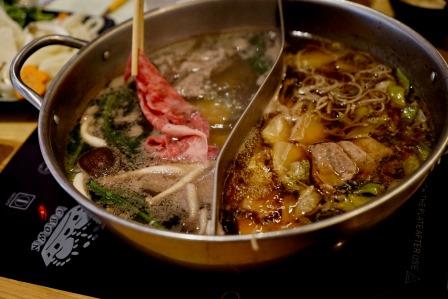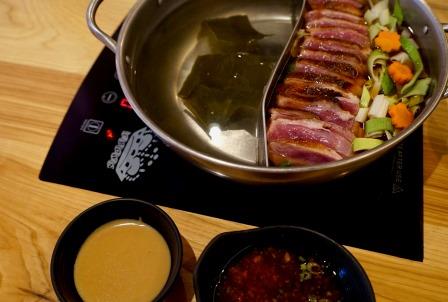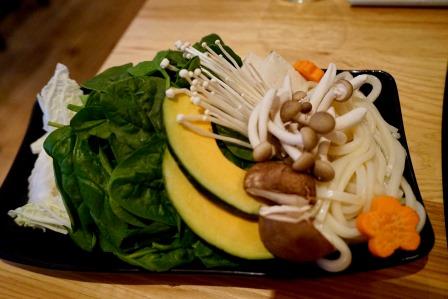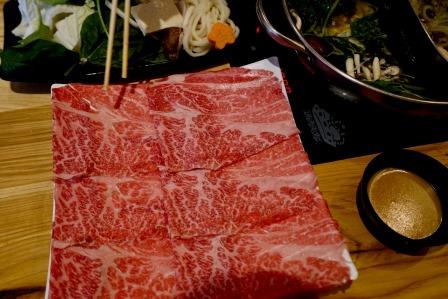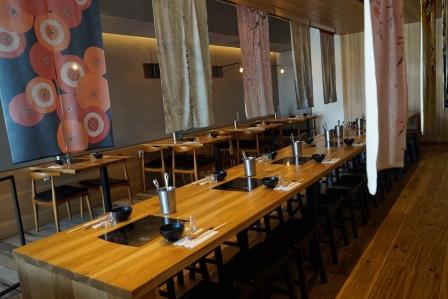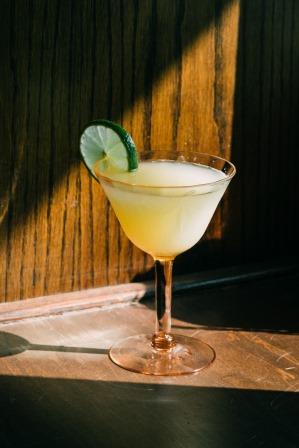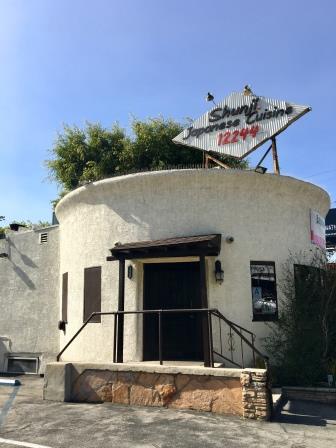“Nabe”, a simple dish with carefully selected good–quality ingredients is breaking through
Text: Mayumi Schroede / Photos: Elli Sekine
In the last few years, the development of Japanese restaurants in San Francisco has been very active. “Nabe” has two locations; one in the Sunset District by the Golden Gate Bridge, and the other, in the Marina District’s high-end shopping streets, both of which are San Francisco’s typical tourist spots. Since its opening, this restaurant chain has been featured in many information magazines including The San Francisco Chronicle, Hoodline, and Eater, and has been attracting a lot of attention. The location I based this report on was the Marina location, which is stylish and modern, but has a Japan-like ambience that has been created with a colorful hanging Noren divider, and Japanese sake bottles decorated on the wall like pieces of art.
The family of the owner, Hilwin Wong, is from Hong Kong. She was born and raised in a restaurant industry family—her grandfather has a restaurant in the Tenderloin District, and her father runs a seafood restaurant, hence she naturally became interested in the restaurant business. For the first 3 years after graduating college, she worked for Cathay Pacific Airlines as a flight attendant.
During that time, she visited many Asian countries and ate at many local restaurants, which got her charmed by delicious Japanese cuisine and its presentation skills. She decided to get into the restaurant business, quit the airline job, and opened the first location in the Sunset District in December of 2012 with the co-owner, Kevin. Then, in November of 2016, the second location in the Marina District opened. She is already thinking about the opening of the third location.
With their motto, “simple, but the best and freshest ingredients”, their collective, well-researched menu based on customers’ needs was born under the consultation of Chef Isamu Kanai. The dashi for all 7 kinds of their nabe is made in-house using Japanese kelp konbu and bonito shavings. Furthermore, original soups such as miso and spicy miso add deeper flavors to the nabe dishes. The meat they use is completely free of anti-biotics and growth hormones. The beef is the highest grade A5 beef from Japan’s Miyazaki prefecture, and the kurobuta pork is procured directly from a farm in Idaho. To retain freshness, all the meat blocks are sliced off after receiving orders. Their particularity shows in everything else as well. The vegetables for the nabe are all organic, and tofu is GMO-free.
All the servers have been trained on how to skim off the scum from the soup, when to add dashi, and when to add vegetables or meats in order for the customers to eat everything in the best cooked condition.
Their pots used in the Nabe restaurants are China-originated divided pots, so you can enjoy 2 kinds of nabe at the same time. According to Mr. Won, the top 3 nabe dishes are #1, Kamonanban ($26), #2, Shabu Shabu ($24), and #3, Ishikari Nabe ($26). Mr. Won also said, “In order to satisfy customers’ stomachs, I would like them to enjoy nabe with matching rice and noodles.ˮ They serve sirataki, udon, ramen, etc. with the nabe. He also said, “We value our ‘no waste’ concept, so I would like them to make zousui (gruel) using the leftover soup to enjoy until the last drop of the nabe”.
This time, I tasted the recommended 2 kinds, “Kamonanban (with soba)”, and “Shabu Shabu (with udon)”. The duck meat for the “Kamonanban” is procured from Maple Leaf Farm in Indiana. Slightly-thick slices of the duck meat are soft, and the rich juice flows out into your mouth with every bite. Mr. Won tells the secret. “To utilize the power of the ingredients, nothing extra should be added.
Just marinade the meat with mirin and shoyu dashi.” As for “Shabu Shabu”, the soup soaks into the thin-sliced Miyazaki wagyu well, and you can enjoy vegetables and meat in 2 different ways with 2 kinds of house-made sauce, ponzu, and goma (sesame) miso. After enjoying the nabe fully, you make rich zousui with the leftover flavorful soup, which was produced by the vegetables and meat, to finish up. This will raise your satisfaction level to maximum.
They carry not only many brands of Japanese sake to match the nabe dishes, but also a local draft beer called “Harajuku Girl Yuzu Lager” of a local beer factory, HolyCraft. You cannot find this rare find anywhere else. Its citrus-flavored refreshing taste is very popular. I highly recommend one to try the nabe dishes, which is perfect for the coming season, along with sake.
良質食材にこだわったシンプルな「Nabe」がブレーク中
ここ数年、日本食レストランの展開の勢いが目覚ましいサンフランシスコ市で、代表的な観光地であるゴールデンゲートパーク沿いのサンセット地区と高級ショッピング街のマリーナ地区の2箇所に店舗を構える「Nabe」。開店以来、サンフランシスコ・クロニクル紙やHoodline、Eaterなど多くの情報誌に掲載される今注目のレストランだ。今回取材したマリーナ地区の店舗はお洒落でモダンな作りだが、和風で色彩豊かな暖簾やアートの様に壁に飾られた日本酒のボトルが和の雰囲気を醸し出している。
オーナーのヒルウィン・ウォン氏の一家は香港出身で、祖父がテンダーロイン地区にレストランを、父親もシーフード・レストランを営む飲食業の家系に生まれ育ち自然とレストラン経営に興味を持つようになった。大学卒業後の約3年間はスチュワーデスとしてキャセイパシフィック航空に勤務し、その際にアジア諸国を訪れレストランを食べ歩き日本食の美味しさとプレゼンテーションに惹きつけられたという。その後、レストラン経営を決意しスチュワーデスを退職、共同オーナーのケビン氏と共に2012年12月にサンセット地区に第1店舗をオープンした。その後、2016年11月に第2店舗目となるマリーナ地区店を開店、将来は第3店舗目のオープンも視野に入れている。
「シンプルだが最高で新鮮な食材を」をモットーに、カナイ・イサム氏がコンサルタントシェフを務め、客のニーズに応え研究を重ねた集大成のメニューが誕生した。全7種類ある鍋のダシは全て自家製で真昆布や鰹節を使っており、他にも味噌や辛味噌などのオリジナルスープが鍋を味わい深いものにしている。使用する肉は抗生物質や成長ホルモンを一切使っておらず、牛肉は宮崎県から最高級のグレードA5の宮崎和牛の肉を、黒豚肉はアイダホ州の農家から直接仕入れており、肉は鮮度を保つ為に注文を受けてからスライスされる。鍋に使用する野菜も全てオーガニックで、豆腐はGMOフリーのものを使用する徹底ぶり。サーバー全員が灰汁の取り方やダシ追加の頃合い、野菜や肉を入れるタイミングなどトレーニングを受けており、客が食材を最高の状態で食べれるように配慮されている。
「Nabe」で使用する鍋は中国発祥の仕切り鍋で、2種類の鍋を同時に楽しめるようになっている。ウォン氏によると、鍋の人気トップ3は1位が「鴨南蛮鍋(26ドル)」、2位が「しゃぶしゃぶ(24ドル)」で3位が「石狩鍋(26ドル)」だという。更にウォン氏は「お客様の胃袋を満足させる為、鍋にあった米・麺類をマッチングして楽しんで頂く」と、シラタキやうどん、ラーメンなどを鍋と共に提供している。また「“もったいない”というコンセプトを大事にしており、最後に残ったスープを雑炊にして最後の1滴まで鍋を楽しんで欲しい」と語る。
そこで今回、お勧めの「鴨南蛮鍋(蕎麦付)」と「しゃぶしゃぶ(うどん付)」の2つを賞味させて頂いた。「鴨南蛮」の鴨肉はインディアナ州のメープルリーフ農場から仕入れている。少し厚めにスライスされているが柔らかい鴨肉は噛む度に濃厚な旨味が染み出し、その秘訣は「素材の力を活かし余計な物は一切加えず、味醂や醤油ダシを染み込ませただけ」とウォン氏。「しゃぶしゃぶ」は薄くスライスされた宮崎和牛にスープが良く染み込み、自家製のポン酢とゴマ味噌の2種類のタレで野菜と肉の味わいを2段階に分けて楽しむ事が出来る。鍋を堪能した後は、野菜と肉の旨味が染み込んだスープで作る贅沢な雑炊で満足度が一気に上がる。
鍋に合わせた日本酒も多く取り揃えている他、ドラフトビールでは他店では見かけない地元ビール工場HolyCraft社の「Harajuku Girl Yuzu ラガー」を仕入れており、柑橘系の爽やかな口当たりが好評だ。これから季節にピッタリの鍋料理、お酒も併せて是非お試し頂きたい。
Nabe
(Sunset District)1325 9th Avenue / Tel: (415) 731-2658
(Marina District)2151 Lombard Street / Tel: (415) 447-6199
Website: www.nabesf.com
Email: info@nabesf.com
Mon.-Thu. & Sun. 5:00pm – 10pm
Fri. & Sat. 5:00pm – 10:30pm
In the last few years, the development of Japanese restaurants in San Francisco has been very active. “Nabe” has two locations; one in the Sunset District by the Golden Gate Bridge, and the other, in the Marina District’s high-end shopping streets, both of which are San Francisco’s typical tourist spots. Since its opening, this restaurant chain has been featured in many information magazines including The San Francisco Chronicle, Hoodline, and Eater, and has been attracting a lot of attention. The location I based this report on was the Marina location, which is stylish and modern, but has a Japan-like ambience that has been created with a colorful hanging Noren divider, and Japanese sake bottles decorated on the wall like pieces of art.
The family of the owner, Hilwin Wong, is from Hong Kong. She was born and raised in a restaurant industry family—her grandfather has a restaurant in the Tenderloin District, and her father runs a seafood restaurant, hence she naturally became interested in the restaurant business. For the first 3 years after graduating college, she worked for Cathay Pacific Airlines as a flight attendant.
During that time, she visited many Asian countries and ate at many local restaurants, which got her charmed by delicious Japanese cuisine and its presentation skills. She decided to get into the restaurant business, quit the airline job, and opened the first location in the Sunset District in December of 2012 with the co-owner, Kevin. Then, in November of 2016, the second location in the Marina District opened. She is already thinking about the opening of the third location.
With their motto, “simple, but the best and freshest ingredients”, their collective, well-researched menu based on customers’ needs was born under the consultation of Chef Isamu Kanai. The dashi for all 7 kinds of their nabe is made in-house using Japanese kelp konbu and bonito shavings. Furthermore, original soups such as miso and spicy miso add deeper flavors to the nabe dishes. The meat they use is completely free of anti-biotics and growth hormones. The beef is the highest grade A5 beef from Japan’s Miyazaki prefecture, and the kurobuta pork is procured directly from a farm in Idaho. To retain freshness, all the meat blocks are sliced off after receiving orders. Their particularity shows in everything else as well. The vegetables for the nabe are all organic, and tofu is GMO-free.
All the servers have been trained on how to skim off the scum from the soup, when to add dashi, and when to add vegetables or meats in order for the customers to eat everything in the best cooked condition.
Their pots used in the Nabe restaurants are China-originated divided pots, so you can enjoy 2 kinds of nabe at the same time. According to Mr. Won, the top 3 nabe dishes are #1, Kamonanban ($26), #2, Shabu Shabu ($24), and #3, Ishikari Nabe ($26). Mr. Won also said, “In order to satisfy customers’ stomachs, I would like them to enjoy nabe with matching rice and noodles.ˮ They serve sirataki, udon, ramen, etc. with the nabe. He also said, “We value our ‘no waste’ concept, so I would like them to make zousui (gruel) using the leftover soup to enjoy until the last drop of the nabe”.
This time, I tasted the recommended 2 kinds, “Kamonanban (with soba)”, and “Shabu Shabu (with udon)”. The duck meat for the “Kamonanban” is procured from Maple Leaf Farm in Indiana. Slightly-thick slices of the duck meat are soft, and the rich juice flows out into your mouth with every bite. Mr. Won tells the secret. “To utilize the power of the ingredients, nothing extra should be added.
Just marinade the meat with mirin and shoyu dashi.” As for “Shabu Shabu”, the soup soaks into the thin-sliced Miyazaki wagyu well, and you can enjoy vegetables and meat in 2 different ways with 2 kinds of house-made sauce, ponzu, and goma (sesame) miso. After enjoying the nabe fully, you make rich zousui with the leftover flavorful soup, which was produced by the vegetables and meat, to finish up. This will raise your satisfaction level to maximum.
They carry not only many brands of Japanese sake to match the nabe dishes, but also a local draft beer called “Harajuku Girl Yuzu Lager” of a local beer factory, HolyCraft. You cannot find this rare find anywhere else. Its citrus-flavored refreshing taste is very popular. I highly recommend one to try the nabe dishes, which is perfect for the coming season, along with sake.
良質食材にこだわったシンプルな「Nabe」がブレーク中
ここ数年、日本食レストランの展開の勢いが目覚ましいサンフランシスコ市で、代表的な観光地であるゴールデンゲートパーク沿いのサンセット地区と高級ショッピング街のマリーナ地区の2箇所に店舗を構える「Nabe」。開店以来、サンフランシスコ・クロニクル紙やHoodline、Eaterなど多くの情報誌に掲載される今注目のレストランだ。今回取材したマリーナ地区の店舗はお洒落でモダンな作りだが、和風で色彩豊かな暖簾やアートの様に壁に飾られた日本酒のボトルが和の雰囲気を醸し出している。
オーナーのヒルウィン・ウォン氏の一家は香港出身で、祖父がテンダーロイン地区にレストランを、父親もシーフード・レストランを営む飲食業の家系に生まれ育ち自然とレストラン経営に興味を持つようになった。大学卒業後の約3年間はスチュワーデスとしてキャセイパシフィック航空に勤務し、その際にアジア諸国を訪れレストランを食べ歩き日本食の美味しさとプレゼンテーションに惹きつけられたという。その後、レストラン経営を決意しスチュワーデスを退職、共同オーナーのケビン氏と共に2012年12月にサンセット地区に第1店舗をオープンした。その後、2016年11月に第2店舗目となるマリーナ地区店を開店、将来は第3店舗目のオープンも視野に入れている。
「シンプルだが最高で新鮮な食材を」をモットーに、カナイ・イサム氏がコンサルタントシェフを務め、客のニーズに応え研究を重ねた集大成のメニューが誕生した。全7種類ある鍋のダシは全て自家製で真昆布や鰹節を使っており、他にも味噌や辛味噌などのオリジナルスープが鍋を味わい深いものにしている。使用する肉は抗生物質や成長ホルモンを一切使っておらず、牛肉は宮崎県から最高級のグレードA5の宮崎和牛の肉を、黒豚肉はアイダホ州の農家から直接仕入れており、肉は鮮度を保つ為に注文を受けてからスライスされる。鍋に使用する野菜も全てオーガニックで、豆腐はGMOフリーのものを使用する徹底ぶり。サーバー全員が灰汁の取り方やダシ追加の頃合い、野菜や肉を入れるタイミングなどトレーニングを受けており、客が食材を最高の状態で食べれるように配慮されている。
「Nabe」で使用する鍋は中国発祥の仕切り鍋で、2種類の鍋を同時に楽しめるようになっている。ウォン氏によると、鍋の人気トップ3は1位が「鴨南蛮鍋(26ドル)」、2位が「しゃぶしゃぶ(24ドル)」で3位が「石狩鍋(26ドル)」だという。更にウォン氏は「お客様の胃袋を満足させる為、鍋にあった米・麺類をマッチングして楽しんで頂く」と、シラタキやうどん、ラーメンなどを鍋と共に提供している。また「“もったいない”というコンセプトを大事にしており、最後に残ったスープを雑炊にして最後の1滴まで鍋を楽しんで欲しい」と語る。
そこで今回、お勧めの「鴨南蛮鍋(蕎麦付)」と「しゃぶしゃぶ(うどん付)」の2つを賞味させて頂いた。「鴨南蛮」の鴨肉はインディアナ州のメープルリーフ農場から仕入れている。少し厚めにスライスされているが柔らかい鴨肉は噛む度に濃厚な旨味が染み出し、その秘訣は「素材の力を活かし余計な物は一切加えず、味醂や醤油ダシを染み込ませただけ」とウォン氏。「しゃぶしゃぶ」は薄くスライスされた宮崎和牛にスープが良く染み込み、自家製のポン酢とゴマ味噌の2種類のタレで野菜と肉の味わいを2段階に分けて楽しむ事が出来る。鍋を堪能した後は、野菜と肉の旨味が染み込んだスープで作る贅沢な雑炊で満足度が一気に上がる。
鍋に合わせた日本酒も多く取り揃えている他、ドラフトビールでは他店では見かけない地元ビール工場HolyCraft社の「Harajuku Girl Yuzu ラガー」を仕入れており、柑橘系の爽やかな口当たりが好評だ。これから季節にピッタリの鍋料理、お酒も併せて是非お試し頂きたい。
Nabe
(Sunset District)1325 9th Avenue / Tel: (415) 731-2658
(Marina District)2151 Lombard Street / Tel: (415) 447-6199
Website: www.nabesf.com
Email: info@nabesf.com
Mon.-Thu. & Sun. 5:00pm – 10pm
Fri. & Sat. 5:00pm – 10:30pm







